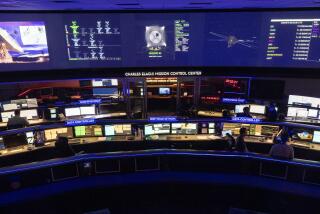JPL: NASA Curiosity rover back to work after Martian spring break
- Share via
NASA’s Mars rover Curiosity has emerged from its “spring break” and is back to work, officials at Jet Propulsion Laboratory said this week. Up next on the agenda: Drilling the second target at Yellowknife Bay.
The Mars Science Laboratory mission made big news shortly before its break, turning up key evidence of life-friendly environments in its first drill sample, said mission deputy project scientist Ashwin Vasavada.
The revelation came just in time. Mars slipped behind the sun during the month of April, in a phenomenon known as solar conjunction. Blocked from earthly view, Curiosity was left off the grid until May 1 -- though it continued to run through a list of chores that included checking the weather each day.
The month off allowed Vasavada and other team members to take a breath and evaluate their progress.
“It was definitely lighter without the hamster wheel of daily operations,” Vasavada said. “It gave us time to work on other things.”
The rover came back into contact with Earth last Wednesday, but this workweek marked its return to science, Vasavada said.
Curiosity wasted no time Monday, taking images of the little piles of drilled rock the rover had deposited on the surface. The images would show them how much of those discarded piles had been blown away, and thus give the researchers a sense of the strength of the wind at ground level.
The researchers plan to drill another rock within a meter or two away, in order to duplicate their groundbreaking results from March -- but they also want to try more complex, challenging targets, Vasavada said.
“We chose that first drill hole partly to be very safe — it was our very first drill hole,” Vasavada said. “So we chose a nice flat slab of rock, even though there’s other places that have a lot more secondary alterations, like veins and concretions.”
Such features will give geologists a sense of the different eras in Mars’ watery history, he added.
After that, it’s off to Mt. Sharp, the 3-mile-high mountain in the middle of Gale Crater whose clay-rich layers should reveal the geologic chapters of the Red Planet’s history.
“We’re planning to make sure we don’t linger around too much longer,” he said.
The break also gave some mission members a chance to take some well-earned vacation time, but not Vasavada.
“I should have -- I kind of regret it now,” Vasavada said. “I kind of got into writing some papers and getting caught up on a lot of other things.”
“I didn’t stay late,” he added. “That’s what we call vacation around here.”
Follow me on Twitter @aminawrite.







